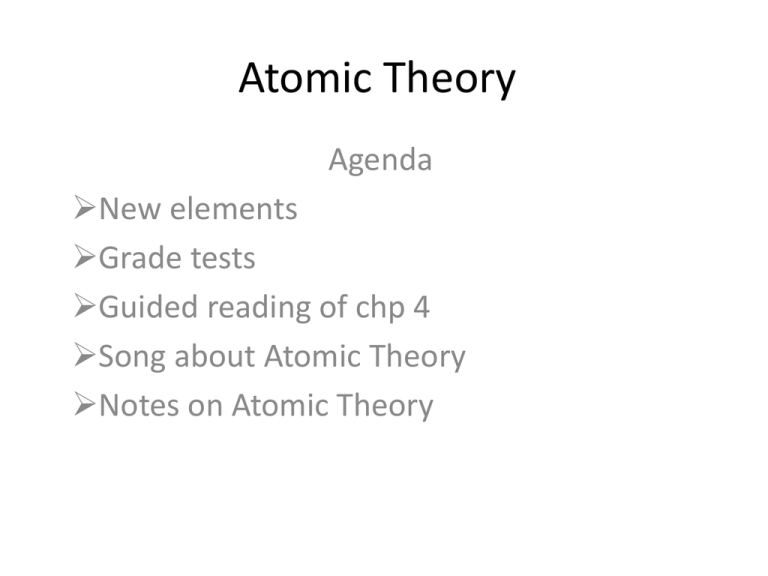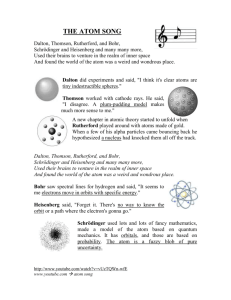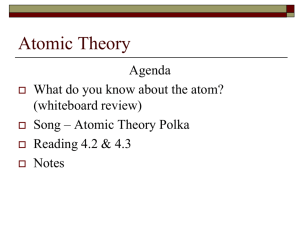Atomic Theory - WaylandHighSchoolChemistry
advertisement

Atomic Theory Agenda New elements Grade tests Guided reading of chp 4 Song about Atomic Theory Notes on Atomic Theory Song Time Atomic Theory Polka • Dalton, Thomson, Rutherford and Bohr. Schrödinger and Heisenberg, and many, many more. Used their brains to venture in the realm of inner space and found the world of the atom was a weird and wondrous place. • Dalton did experiments and said, “I think it’s clear, atoms are tiny indestructible spheres.” • Thomson worked with cathode rays and said, “I disagree. A plum-pudding model makes much more sense to me.” • A new chapter in atomic theory started to unfold when Rutherford played around with atoms made of gold. When a few of his alpha particles came bounding back, he hypothesized a nucleus had knocked them off the track. • Dalton, Thomson, Rutherford and Bohr. Schrödinger and Heisenberg, and many, many more. Used their brains to venture in the realm of inner space and found the world of the atom was a weird and wondrous place. • Bohr saw spectral lines for hydrogen and said, “It seems to me.. Electrons move in orbits with specific energies.” electron neutron proton • Heisenberg said, “Forget it, there’s no way to know the orbit or a path, where the electron’s gonna go.” • Schrödinger used lots and lots of fancy mathematics, and made a model of the atom based on quantum mechanics. It has orbitals and those are based on probability. The atom is a fuzzy blob of pure uncertainty. • Dalton, Thomson, Rutherford and Bohr. Schrödinger and Heisenberg, and many, many more. Used their brains to venture in the realm of inner space and found the world of the atom was a weird and wondrous place. Atomic Theory Date Democritus • Date 460-370 B.C. • Democritus was a philosopher; did no research • He thought that everything was made up of tiny round things called atoms. • Atoms are the building blocks of life. John Dalton • 1787 – 1844 • Wanted to learn in what ratios different elements combine in chemical reactions. • Through experimentation devised his atomic theory. Dalton’s Atomic Theory 1. Elements are composed of submicroscopic indivisible particles called atoms. 2. All atoms of a given element are identical. Atoms of different elements are different from one another. 3. Atoms of one element can mix or chemically combine with atoms of other elements, creating compounds with simple whole-number ratios. 4. Chemical reactions occur when atoms are separated, joined or rearrange. JJ Thomson • • • • Found electron Used cathode ray tube “Plum Pudding” or “Chocolate Chip Cookies” model video of cathode ray bending http://tinyurl.com/6laasks Robert Millikan • Determined the electrical charge of electron • “Oil Drop Experiment” – like a balloon attracting a bubble up while gravity pulls bubble down. • Still plum pudding model Eugen Goldstein • Found the proton • Reverse cathode ray tube • Still plum pudding model Ernest Rutherford • Found nucleus • Gold foil experiment • Atom is mostly empty space – first nuclear model James Chadwick • Found neutron • Shot alpha particles at Be nucleus • Nucleus is made of two particles – Positive protons – Neutral neutrons Niels Bohr • Planetary model • Proposed electrons have a set amount of energy putting them in different energy levels, or orbits around the nucleus. • Electrons can change energy levels; higher energy levels are further from the nucleus. electron neutron proton Heisenberg’s uncertainty principle • Heisenberg’s uncertainty principle: cannot know exactly both the velocity and position of electron at the same time. • Like trying to catch a helium balloon in the dark. Schrödinger • Electron cloud gives a 90% probability of finding the electron within the darkly shaded area. • Electrons move like moths around a light – unpredictable.





